stop start MITSUBISHI SHOGUN 2016 (in English) Owner's Guide
[x] Cancel search | Manufacturer: MITSUBISHI, Model Year: 2016, Model line: SHOGUN, Model: MITSUBISHI SHOGUN 2016Pages: 404, PDF Size: 18.95 MB
Page 179 of 404
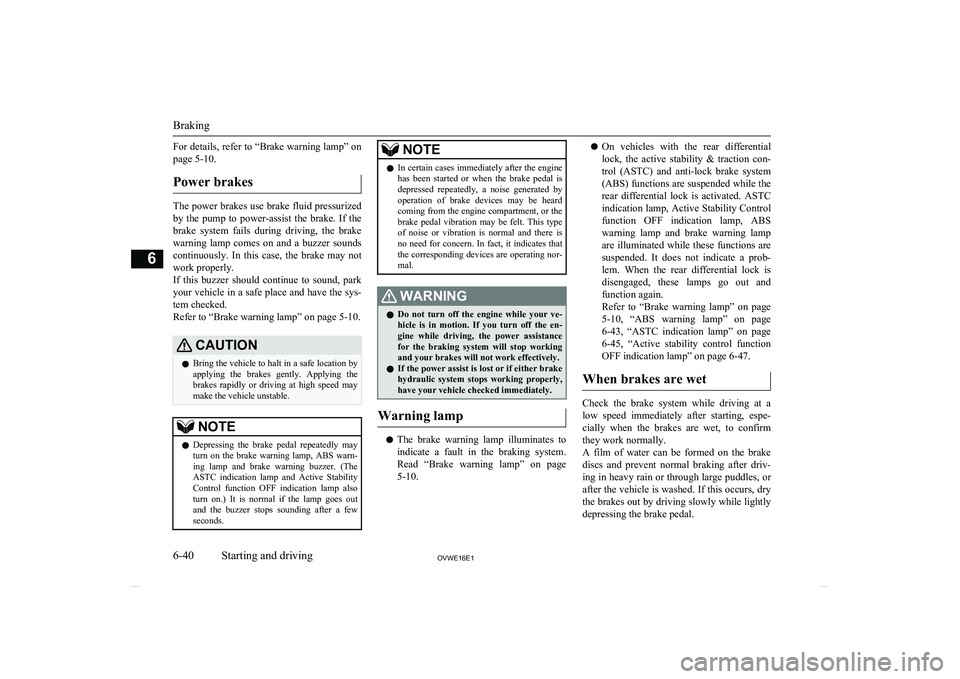
For details, refer to “Brake warning lamp” on
page 5-10.
Power brakes
The power brakes use brake fluid pressurized by the pump to power-assist the brake. If the brake system fails during driving, the brake
warning lamp comes on and a buzzer sounds continuously. In this case, the brake may not
work properly.
If this buzzer should continue to sound, park your vehicle in a safe place and have the sys-tem checked.
Refer to “Brake warning lamp” on page 5-10.
CAUTIONl Bring the vehicle to halt in a safe location by
applying the brakes gently. Applying the
brakes rapidly or driving at high speed may
make the vehicle unstable.NOTEl Depressing the brake pedal repeatedly may
turn on the brake warning lamp, ABS warn-ing lamp and brake warning buzzer. (The
ASTC indication lamp and Active Stability
Control function OFF indication lamp also
turn on.) It is normal if the lamp goes out and the buzzer stops sounding after a few
seconds.NOTEl In certain cases immediately after the engine
has been started or when the brake pedal is
depressed repeatedly, a noise generated by operation of brake devices may be heard coming from the engine compartment, or the
brake pedal vibration may be felt. This type
of noise or vibration is normal and there is
no need for concern. In fact, it indicates that
the corresponding devices are operating nor-
mal.WARNINGl Do not turn off the engine while your ve-
hicle is in motion. If you turn off the en-
gine while driving, the power assistance
for the braking system will stop working and your brakes will not work effectively.
l If the power assist is lost or if either brake
hydraulic system stops working properly,
have your vehicle checked immediately.
Warning lamp
l The brake warning lamp illuminates to
indicate a fault in the braking system.
Read “Brake warning lamp” on page
5-10.
l On vehicles with the rear differential
lock, the active stability & traction con-
trol (ASTC) and anti-lock brake system (ABS) functions are suspended while the
rear differential lock is activated. ASTC
indication lamp, Active Stability Control function OFF indication lamp, ABS warning lamp and brake warning lamp are illuminated while these functions are
suspended. It does not indicate a prob- lem. When the rear differential lock is
disengaged, these lamps go out and
function again.
Refer to “Brake warning lamp” on page
5-10 , “ABS warning lamp” on page
6-43 , “ASTC indication lamp” on page
6-45 , “Active stability control function
OFF indication lamp” on page 6-47.
When brakes are wet
Check the brake system while driving at a
low speed immediately after starting, espe- cially when the brakes are wet, to confirmthey work normally.
A film of water can be formed on the brake
discs and prevent normal braking after driv-
ing in heavy rain or through large puddles, or after the vehicle is washed. If this occurs, dry
the brakes out by driving slowly while lightly depressing the brake pedal.
Braking
6-40OVWE16E1Starting and driving6
Page 180 of 404

When driving downhill
It is important to take advantage of the en-
gine braking by shifting to a lower shift posi- tion while driving on steep downhill roads in
order to prevent the brakes from overheating.
WARNINGl Do not leave any objects near the brake
pedal or let a floor mat slide under it; do-
ing so could prevent the full pedal stroke that would be necessary in an emergency.Make sure that the pedal can be operated freely at all times. Make sure the floor mat is securely held in place.
Brake pads
l Avoid hard braking situations.
New brakes need to be broken-in by
moderate use for the first 200 km (125 miles).
l The disc brakes are provided with a
warning device which emits a shrieking
metallic sound while braking if the brake pads have reached their wear limit.
If you hear this sound, have the brake pads replaced immediately.
WARNINGl Driving with worn brake pads will make
it harder to stop, and can cause an acci-
dent.Brake assist system
E00627000376
The brake assist system is a device assistingdrivers who cannot depress the brake pedalfirmly when it is necessary to do so (such as
in emergency stop situations) and provides
greater braking force.
If the brake pedal is depressed suddenly, the brakes will be applied with more force thanusual.
CAUTIONl The brake assist system is not a device de-
signed to exercise braking force greater than its capacity. Make sure to always keep a suf-
ficient distance between vehicles in front of
you without relying too much on the brake
assist system.NOTEl Once the brake assist system is operational,
it maintains great braking force even if the
brake pedal is lightly released.
To stop its operation, completely remove
your foot from the brake pedal.
l When the brake assist system is in use while
driving, you may feel the brake pedal at-
tempt to resist, the pedal moves in small mo- tions in conjunction with the operation
noise, or the vehicle body and the steering wheel vibrate. This occurs when the brake
assist system is operating normally and does not indicate faulty operation. Continue to
firmly depress the brake pedal.
l When the anti-lock brake system warning
lamp is illuminated, the brake assist system is not functioning.Anti-lock brake system
(ABS) E00607101248
Environmental conditions can have an effect
on braking. During sudden braking when
there is snow, ice, oil, water etc. on the road
surface, a skid may occur. In this situation, steering control and braking effectiveness is
reduced and the stopping distance is in-
creased. The vehicle may also go into an un- controlled spin.
Brake assist system
6-41OVWE16E1Starting and driving6
Page 181 of 404
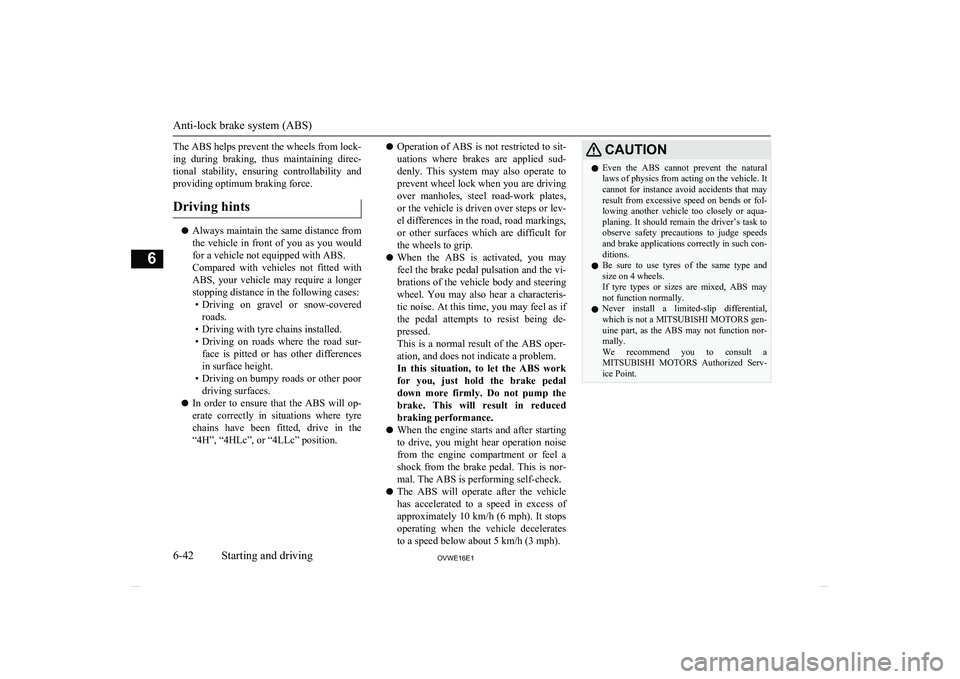
The ABS helps prevent the wheels from lock-
ing during braking, thus maintaining direc-
tional stability, ensuring controllability and
providing optimum braking force.
Driving hints
l Always maintain the same distance from
the vehicle in front of you as you would
for a vehicle not equipped with ABS.
Compared with vehicles not fitted with ABS, your vehicle may require a longer
stopping distance in the following cases: • Driving on gravel or snow-covered
roads.
• Driving with tyre chains installed.
• Driving on roads where the road sur-
face is pitted or has other differencesin surface height.
• Driving on bumpy roads or other poor
driving surfaces.
l In order to ensure that the ABS will op-
erate correctly in situations where tyre chains have been fitted, drive in the“4H”, “4HLc”, or “4LLc” position.
l Operation of ABS is not restricted to sit-
uations where brakes are applied sud- denly. This system may also operate to
prevent wheel lock when you are driving
over manholes, steel road-work plates, or the vehicle is driven over steps or lev-
el differences in the road, road markings,
or other surfaces which are difficult for the wheels to grip.
l When the ABS is activated, you may
feel the brake pedal pulsation and the vi- brations of the vehicle body and steering
wheel. You may also hear a characteris-
tic noise. At this time, you may feel as if
the pedal attempts to resist being de- pressed.
This is a normal result of the ABS oper- ation, and does not indicate a problem.
In this situation, to let the ABS work for you, just hold the brake pedal
down more firmly. Do not pump the brake. This will result in reduced
braking performance.
l When the engine starts and after starting
to drive, you might hear operation noise from the engine compartment or feel a shock from the brake pedal. This is nor-
mal. The ABS is performing self-check.
l The ABS will operate after the vehicle
has accelerated to a speed in excess ofapproximately 10 km/h (6 mph). It stops
operating when the vehicle decelerates
to a speed below about 5 km/h (3 mph).CAUTIONl Even the ABS cannot prevent the natural
laws of physics from acting on the vehicle. Itcannot for instance avoid accidents that may
result from excessive speed on bends or fol- lowing another vehicle too closely or aqua- planing. It should remain the driver’s task to
observe safety precautions to judge speeds and brake applications correctly in such con-
ditions.
l Be sure to use tyres of the same type and
size on 4 wheels.
If tyre types or sizes are mixed, ABS may not function normally.
l Never install a limited-slip differential,
which is not a MITSUBISHI MOTORS gen-
uine part, as the ABS may not function nor-
mally.
We recommend you to consult a MITSUBISHI MOTORS Authorized Serv-
ice Point.
Anti-lock brake system (ABS)
6-42OVWE16E1Starting and driving6
Page 182 of 404

ABS warning lamp
E00607200532
The ABS warning lamp should illuminate
when the ignition switch is turned “ON”, and should go off in a few seconds.
CAUTIONl If the warning lamp stays on or does not illu-
minate when you start the vehicle, it indi-
cates that the ABS is not functioning and
that only the standard brake system is in op-
eration. (In this condition the standard hy- draulic brake system will still function.) We
recommend you to have your vehicle inspec- ted as soon as possible.NOTEl Depressing the brake pedal repeatedly may
turn on the brake warning lamp, ABS warn-ing lamp and brake warning buzzer. (The
ASTC indication lamp and Active Stability
Control function OFF indication lamp also
turn on.) It is normal if the lamp goes out and the buzzer stops sounding after a few
seconds.
l On vehicles with the rear differential lock,
the active stability & traction control
(ASTC) and anti-lock brake system (ABS)
functions are suspended while the rear dif- ferential lock is activated. ASTC indication
lamp, Active Stability Control function OFF indication lamp, ABS warning lamp and
brake warning lamp are illuminated while these functions are suspended. It does not in-
dicate a problem. When the rear differential lock is disengaged, these lamps go out and
function again.
Refer to “Brake warning lamp” on page
5-10 , “ASTC indication lamp” on page
6-45 , “Active stability control function OFF
indication lamp” on page 6-47.If the warning lamp illuminates
while driving
E00607300416
If only the ABS warning lamp illuminates
l Avoid hard braking and high-speed driv-
ing. Stop the vehicle in a safe place.
Restart the engine and check to see whether the lamp goes out after a few
minutes driving; if it then remains off during driving, there is no problem.
However, if the lamp does not go out, or if it lights up again when the vehicle is
driven, we recommend you to have the
vehicle checked as soon as possible.
l The ABS warning lamp can illuminate if
the battery voltage is insufficient when the engine is started. In this case, it doesnot indicate an ABS fault.
Charge the battery by allowing the en- gine to idle for a while.
If the battery has been charged but the
ABS warning lamp continues to illumi-
nate or illuminates intermittently, we recommend you to have the vehicle in-
spected.
Anti-lock brake system (ABS)
6-43OVWE16E1Starting and driving6
Page 183 of 404
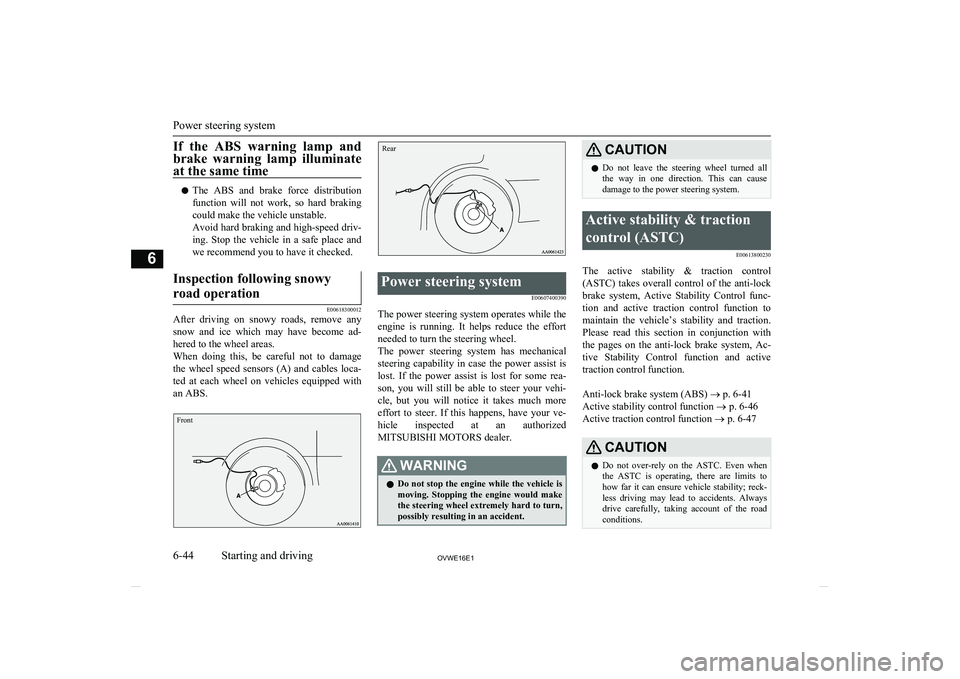
If the ABS warning lamp and
brake warning lamp illuminate at the same time
l The ABS and brake force distribution
function will not work, so hard braking
could make the vehicle unstable.
Avoid hard braking and high-speed driv- ing. Stop the vehicle in a safe place and we recommend you to have it checked.
Inspection following snowy
road operation
E00618300012
After driving on snowy roads, remove any snow and ice which may have become ad-
hered to the wheel areas.
When doing this, be careful not to damage the wheel speed sensors (A) and cables loca-ted at each wheel on vehicles equipped with an ABS.
FrontRear
Power steering system
E00607400390
The power steering system operates while the
engine is running. It helps reduce the effort needed to turn the steering wheel.
The power steering system has mechanical
steering capability in case the power assist is lost. If the power assist is lost for some rea-
son, you will still be able to steer your vehi-
cle, but you will notice it takes much more effort to steer. If this happens, have your ve-
hicle inspected at an authorized MITSUBISHI MOTORS dealer.
WARNINGl Do not stop the engine while the vehicle is
moving. Stopping the engine would make the steering wheel extremely hard to turn,
possibly resulting in an accident.CAUTIONl Do not leave the steering wheel turned all
the way in one direction. This can causedamage to the power steering system.Active stability & traction
control (ASTC) E00613800230
The active stability & traction control(ASTC) takes overall control of the anti-lockbrake system, Active Stability Control func-
tion and active traction control function to
maintain the vehicle’s stability and traction. Please read this section in conjunction withthe pages on the anti-lock brake system, Ac-
tive Stability Control function and active
traction control function.
Anti-lock brake system (ABS) ® p. 6-41
Active stability control function ® p. 6-46
Active traction control function ® p. 6-47
CAUTIONl Do not over-rely on the ASTC. Even when
the ASTC is operating, there are limits to how far it can ensure vehicle stability; reck-
less driving may lead to accidents. Always
drive carefully, taking account of the road conditions.
Power steering system
6-44OVWE16E1Starting and driving6
Page 185 of 404
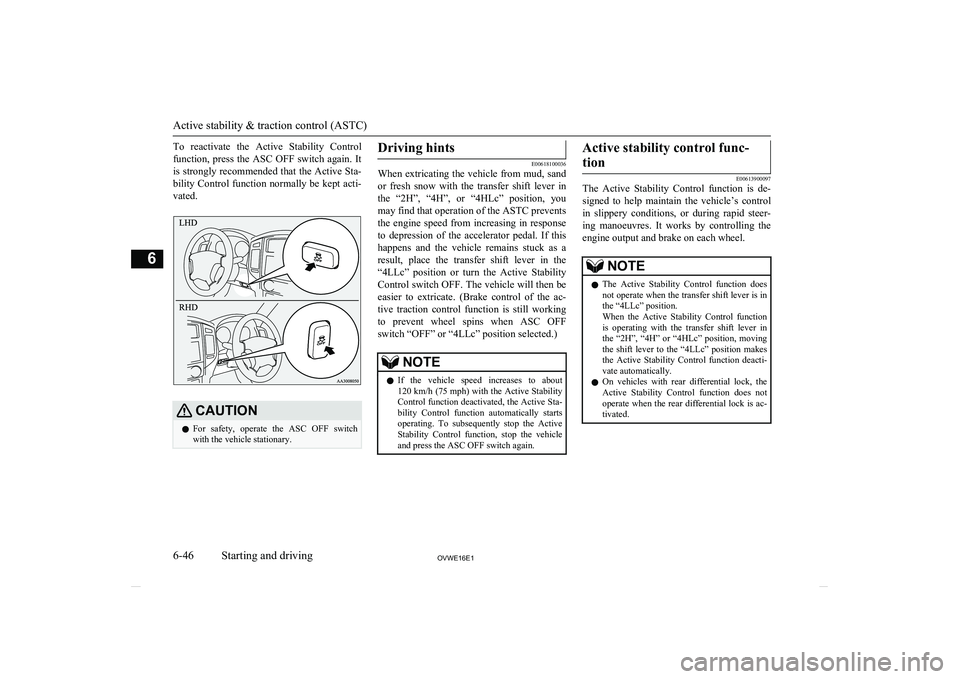
To reactivate the Active Stability Controlfunction, press the ASC OFF switch again. It is strongly recommended that the Active Sta-
bility Control function normally be kept acti-
vated.CAUTIONl For safety, operate the ASC OFF switch
with the vehicle stationary.Driving hints
E00618100036
When extricating the vehicle from mud, sand
or fresh snow with the transfer shift lever in
the “2H”, “4H”, or “4HLc” position, you may find that operation of the ASTC preventsthe engine speed from increasing in response
to depression of the accelerator pedal. If this happens and the vehicle remains stuck as a
result, place the transfer shift lever in the “4LLc” position or turn the Active Stability
Control switch OFF. The vehicle will then be
easier to extricate. (Brake control of the ac- tive traction control function is still working
to prevent wheel spins when ASC OFF
switch “OFF” or “4LLc” position selected.)
NOTEl If the vehicle speed increases to about
120 km/h (75 mph) with the Active Stability Control function deactivated, the Active Sta-bility Control function automatically starts operating. To subsequently stop the Active
Stability Control function, stop the vehicle
and press the ASC OFF switch again.Active stability control func-
tion
E00613900097
The Active Stability Control function is de-
signed to help maintain the vehicle’s control
in slippery conditions, or during rapid steer- ing manoeuvres. It works by controlling theengine output and brake on each wheel.
NOTEl The Active Stability Control function does
not operate when the transfer shift lever is inthe “4LLc” position.
When the Active Stability Control function
is operating with the transfer shift lever in the “2H”, “4H” or “4HLc” position, moving
the shift lever to the “4LLc” position makes
the Active Stability Control function deacti- vate automatically.
l On vehicles with rear differential lock, the
Active Stability Control function does not operate when the rear differential lock is ac-
tivated.
Active stability & traction control (ASTC)
6-46OVWE16E1Starting and driving6
Page 186 of 404

Active stability control functionindication lamp
E00614000183
Active stability control function in- dication lampActive stability control function
OFF indication lamp
The indication lamps should illuminate when
the ignition switch is turned to the “ON” po- sition and should go off after a few seconds.
If the indication lamps stay on or do not illu-
minate when the ignition switch is turned to the “ON” position, we recommend you to
have your vehicle inspected.
indication lamp blinks when the Active
Stability Control function is operating.
indication lamp illuminates when the Ac-
tive Stability Control function is deactivated by either of the following operations:
l The ASC OFF switch is pressed to deac-
tivate the system.
l The transfer shift lever is placed in the
“4LLc” position.CAUTIONl When indication lamp blinks, the Active
Stability Control function is operating,
which means that the road is slippery or that your vehicle’s wheels are spinning exces- sively. If this happens, drive slower with lessaccelerator input.
l If a fault occurs in the device, the ABS
warning lamp or
and indication lamps
illuminate as warning. Park your vehicle in a
safe place and stop the engine. Then, start the engine again and check whether the ABS
warning lamp or
and indication lamps
go out.
If the ABS warning lamp or
and indi-
cation lamps remains lit even after the en- gine has been started, we recommend you tohave your vehicle checked.
NOTEl Immediately after reconnection of the bat-
tery cable, the indication lamp will illu-
minate and the Active Stability Control
function will stop operating. If the vehicle is
driven and the
indication lamp goes off,
the Active Stability Control function will
again start operating.
If the indication lamp illuminates again or il-
luminates even though the battery has not been disconnected, an insufficient battery
voltage or other problems may be the reason.
We recommend you to have your vehicle in- spected.
Active traction control function
E00614100041
The active traction control function maintains
traction on slippery road surfaces by auto-
matically controlling the engine output and applying the brakes so the driving wheels are prevented from spinning.
The active traction control function automati-
cally turns ON when the ignition switch is
turned to the “ON” position.
Active stability & traction control (ASTC)
6-47OVWE16E1Starting and driving6
Page 187 of 404
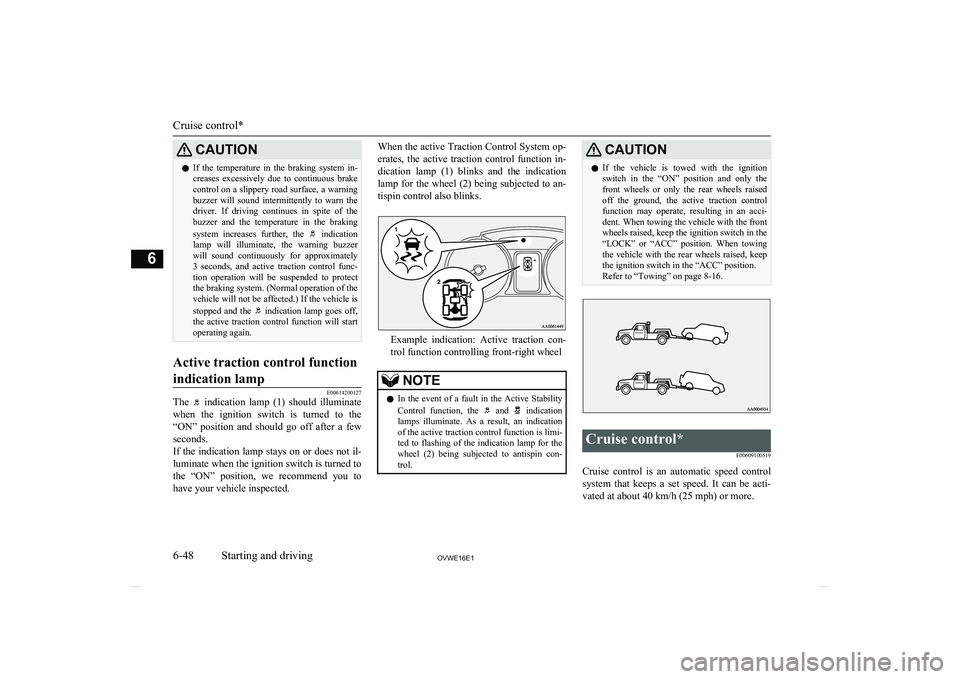
CAUTIONlIf the temperature in the braking system in-
creases excessively due to continuous brake
control on a slippery road surface, a warning
buzzer will sound intermittently to warn the driver. If driving continues in spite of the
buzzer and the temperature in the braking
system increases further, the
indication
lamp will illuminate, the warning buzzer will sound continuously for approximately
3 seconds, and active traction control func- tion operation will be suspended to protectthe braking system. (Normal operation of thevehicle will not be affected.) If the vehicle is
stopped and the
indication lamp goes off,
the active traction control function will start
operating again.
Active traction control function
indication lamp
E00614200127
The indication lamp (1) should illuminate
when the ignition switch is turned to the
“ON” position and should go off after a few seconds.
If the indication lamp stays on or does not il-
luminate when the ignition switch is turned to
the “ON” position, we recommend you to
have your vehicle inspected.
When the active Traction Control System op-
erates, the active traction control function in-dication lamp (1) blinks and the indication
lamp for the wheel (2) being subjected to an- tispin control also blinks.
Example indication: Active traction con- trol function controlling front-right wheel
NOTEl In the event of a fault in the Active Stability
Control function, the and indication
lamps illuminate. As a result, an indication
of the active traction control function is limi- ted to flashing of the indication lamp for the
wheel (2) being subjected to antispin con- trol.CAUTIONl If the vehicle is towed with the ignition
switch in the “ON” position and only the
front wheels or only the rear wheels raised off the ground, the active traction control
function may operate, resulting in an acci-
dent. When towing the vehicle with the front wheels raised, keep the ignition switch in the
“LOCK” or “ACC” position. When towing the vehicle with the rear wheels raised, keep the ignition switch in the “ACC” position.
Refer to “Towing” on page 8-16.Cruise control*
E00609100519
Cruise control is an automatic speed controlsystem that keeps a set speed. It can be acti-vated at about 40 km/h (25 mph) or more.
Cruise control*
6-48OVWE16E1Starting and driving6
Page 193 of 404
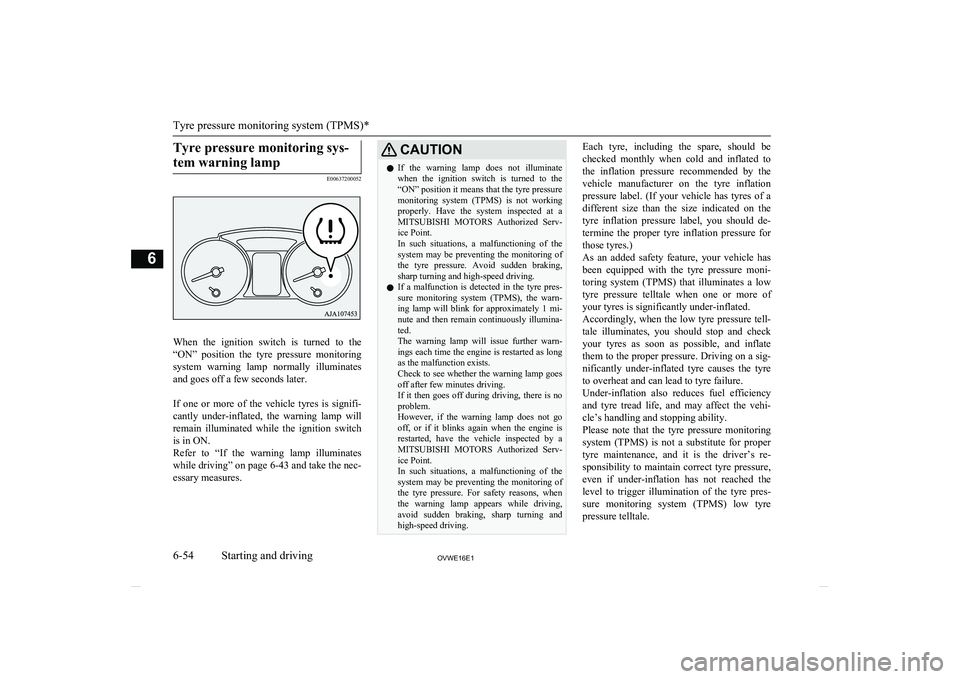
Tyre pressure monitoring sys-tem warning lamp
E00637200052
When the ignition switch is turned to the
“ON” position the tyre pressure monitoring system warning lamp normally illuminates
and goes off a few seconds later.
If one or more of the vehicle tyres is signifi- cantly under-inflated, the warning lamp will
remain illuminated while the ignition switch is in ON.
Refer to “If the warning lamp illuminates while driving” on page 6-43 and take the nec-essary measures.
CAUTIONl If the warning lamp does not illuminate
when the ignition switch is turned to the
“ON” position it means that the tyre pressure monitoring system (TPMS) is not working
properly. Have the system inspected at a MITSUBISHI MOTORS Authorized Serv-
ice Point.
In such situations, a malfunctioning of the system may be preventing the monitoring of the tyre pressure. Avoid sudden braking,
sharp turning and high-speed driving.
l If a malfunction is detected in the tyre pres-
sure monitoring system (TPMS), the warn-
ing lamp will blink for approximately 1 mi-
nute and then remain continuously illumina- ted.
The warning lamp will issue further warn-
ings each time the engine is restarted as long
as the malfunction exists.
Check to see whether the warning lamp goes
off after few minutes driving.
If it then goes off during driving, there is no problem.
However, if the warning lamp does not go off, or if it blinks again when the engine is
restarted, have the vehicle inspected by a
MITSUBISHI MOTORS Authorized Serv-
ice Point.
In such situations, a malfunctioning of the system may be preventing the monitoring of
the tyre pressure. For safety reasons, when the warning lamp appears while driving,
avoid sudden braking, sharp turning and high-speed driving.Each tyre, including the spare, should be
checked monthly when cold and inflated to the inflation pressure recommended by thevehicle manufacturer on the tyre inflation
pressure label. (If your vehicle has tyres of a different size than the size indicated on the
tyre inflation pressure label, you should de-
termine the proper tyre inflation pressure for those tyres.)
As an added safety feature, your vehicle has been equipped with the tyre pressure moni-
toring system (TPMS) that illuminates a low
tyre pressure telltale when one or more of
your tyres is significantly under-inflated.
Accordingly, when the low tyre pressure tell-
tale illuminates, you should stop and check your tyres as soon as possible, and inflate
them to the proper pressure. Driving on a sig- nificantly under-inflated tyre causes the tyre to overheat and can lead to tyre failure.
Under-inflation also reduces fuel efficiency
and tyre tread life, and may affect the vehi- cle’s handling and stopping ability.
Please note that the tyre pressure monitoring
system (TPMS) is not a substitute for proper tyre maintenance, and it is the driver’s re-sponsibility to maintain correct tyre pressure,
even if under-inflation has not reached the level to trigger illumination of the tyre pres-
sure monitoring system (TPMS) low tyre pressure telltale.
Tyre pressure monitoring system (TPMS)*
6-54OVWE16E1Starting and driving6
Page 194 of 404
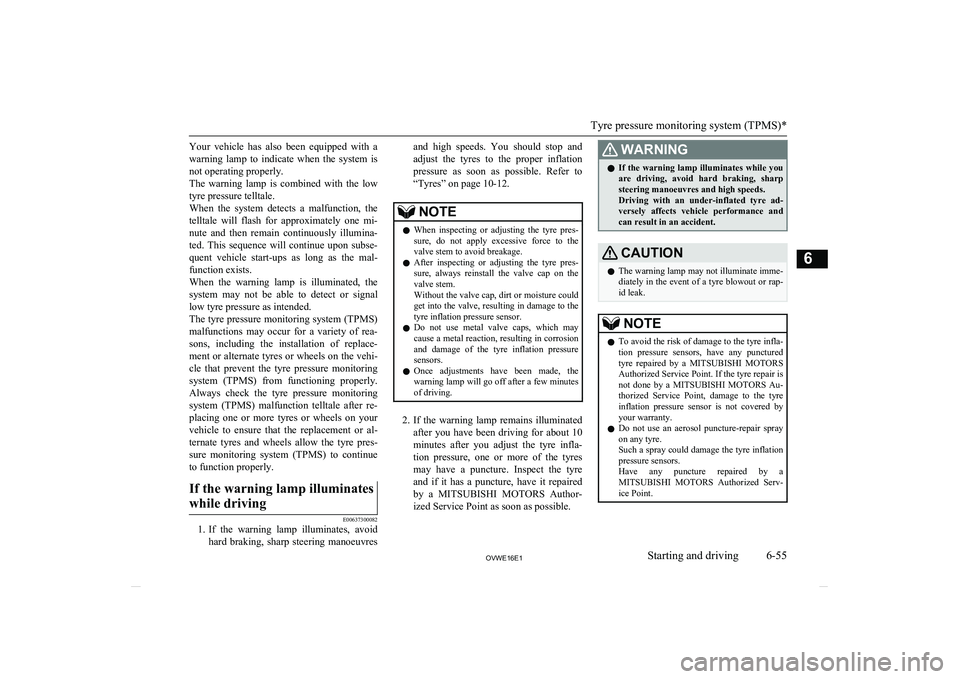
Your vehicle has also been equipped with a
warning lamp to indicate when the system is
not operating properly.
The warning lamp is combined with the low tyre pressure telltale.
When the system detects a malfunction, the
telltale will flash for approximately one mi- nute and then remain continuously illumina-
ted. This sequence will continue upon subse- quent vehicle start-ups as long as the mal-
function exists.
When the warning lamp is illuminated, the
system may not be able to detect or signal low tyre pressure as intended.
The tyre pressure monitoring system (TPMS)
malfunctions may occur for a variety of rea- sons, including the installation of replace- ment or alternate tyres or wheels on the vehi-cle that prevent the tyre pressure monitoring
system (TPMS) from functioning properly. Always check the tyre pressure monitoring
system (TPMS) malfunction telltale after re- placing one or more tyres or wheels on yourvehicle to ensure that the replacement or al- ternate tyres and wheels allow the tyre pres-
sure monitoring system (TPMS) to continue to function properly.If the warning lamp illuminates
while driving
E00637300082
1. If the warning lamp illuminates, avoid
hard braking, sharp steering manoeuvres
and high speeds. You should stop and
adjust the tyres to the proper inflation pressure as soon as possible. Refer to “Tyres” on page 10-12.NOTEl When inspecting or adjusting the tyre pres-
sure, do not apply excessive force to the valve stem to avoid breakage.
l After inspecting or adjusting the tyre pres-
sure, always reinstall the valve cap on the valve stem.
Without the valve cap, dirt or moisture could
get into the valve, resulting in damage to the tyre inflation pressure sensor.
l Do not use metal valve caps, which may
cause a metal reaction, resulting in corrosion
and damage of the tyre inflation pressure sensors.
l Once adjustments have been made, the
warning lamp will go off after a few minutes of driving.
2. If the warning lamp remains illuminated
after you have been driving for about 10
minutes after you adjust the tyre infla- tion pressure, one or more of the tyresmay have a puncture. Inspect the tyreand if it has a puncture, have it repaired
by a MITSUBISHI MOTORS Author-
ized Service Point as soon as possible.
WARNINGl If the warning lamp illuminates while you
are driving, avoid hard braking, sharp steering manoeuvres and high speeds.
Driving with an under-inflated tyre ad-
versely affects vehicle performance and
can result in an accident.CAUTIONl The warning lamp may not illuminate imme-
diately in the event of a tyre blowout or rap-
id leak.NOTEl To avoid the risk of damage to the tyre infla-
tion pressure sensors, have any punctured
tyre repaired by a MITSUBISHI MOTORS
Authorized Service Point. If the tyre repair is
not done by a MITSUBISHI MOTORS Au-
thorized Service Point, damage to the tyre
inflation pressure sensor is not covered by your warranty.
l Do not use an aerosol puncture-repair spray
on any tyre.
Such a spray could damage the tyre inflation
pressure sensors.
Have any puncture repaired by a MITSUBISHI MOTORS Authorized Serv-
ice Point.
Tyre pressure monitoring system (TPMS)*
6-55OVWE16E1Starting and driving6